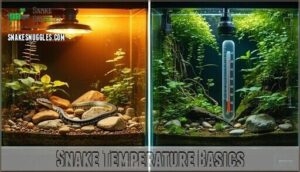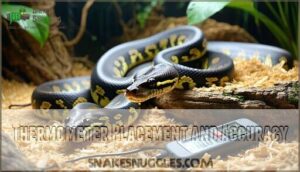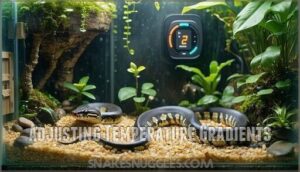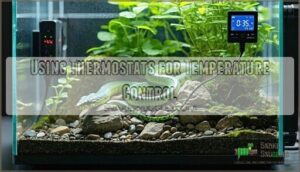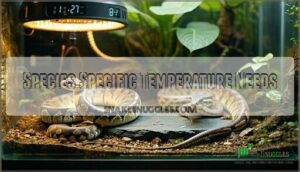This site is supported by our readers. We may earn a commission, at no cost to you, if you purchase through links.
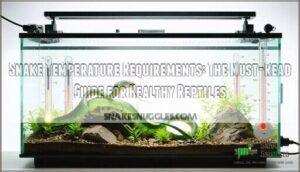 You’ll need to provide the right snake temperature requirements for your scaly friend to thrive.
You’ll need to provide the right snake temperature requirements for your scaly friend to thrive.
Most snakes need a temperature gradient with a warm basking area (85-95°F) and a cooler side (75-85°F). You must create this range so your snake can regulate its body temperature by moving between zones.
Different species have specific needs—ball pythons prefer warmer temperatures than corn snakes, for instance.
Nighttime temperatures can drop slightly but shouldn’t fall below 70°F for most species.
Proper heating equipment with thermostats prevents dangerous temperature swings that could stress or harm your reptile companion.
Table Of Contents
- Key Takeaways
- Snake Temperature Basics
- Creating Basking Spots
- Maintaining Nighttime Temperatures
- Heating and Humidity Solutions
- Species Specific Temperature Needs
- Frequently Asked Questions (FAQs)
- At what temperature is it too cold for snakes?
- What temperature should a snake cage be?
- What is the best temperature for snakes?
- Can you leave a heat lamp on 24/7 for ball python?
- What temperature does a snake need?
- Do snakes need a heat source?
- Do snakes need a thermometer or hygrometer?
- What temperature should a snake enclosure be?
- Do snakes need humidity?
- What is the ideal temperature for corn snakes?
- Conclusion
Key Takeaways
- You’ll need to create a temperature gradient in your snake’s enclosure with a warm basking area (85-95°F) and a cooler side (75-85°F) to allow your pet to regulate its body temperature naturally.
- Your snake’s species determines its specific temperature needs – tropical species like Ball Pythons require warmer environments (80-85°F) than temperate species like Corn Snakes (70-75°F).
- You should lower your snake’s enclosure temperature by 5-10°F during nighttime hours to mimic their natural habitat cycle and support proper digestion and circadian rhythm.
- You must use thermostats with your heating equipment to prevent dangerous temperature fluctuations that can cause stress, respiratory infections, digestion problems, or fatal overheating.
Snake Temperature Basics
You’ll need to maintain specific temperatures in your snake’s enclosure to guarantee proper digestion, metabolism, and overall health.
Most snake species thrive when you provide a temperature gradient ranging from 75°F to 95°F, allowing them to regulate their body temperature by moving between warmer and cooler areas.
Importance of Temperature Control
For your snake’s survival, temperature control isn’t just important—it’s essential.
Proper heat directly impacts digestion, metabolism, and overall health.
When temperatures drop too low, you’ll notice sluggishness signs as their systems slow down.
Conversely, excessive heat increases dehydration risks.
Unlike mammals, snakes can’t regulate their body temperature internally, making your careful management of their enclosure temperature critical to their wellbeing, and directly affecting their overall health.
Careful temperature management is vital for your snake’s health, ensuring proper digestion, metabolism, and overall well-being in their enclosure.
Ideal Temperature Ranges
Now that you understand why temperature matters, let’s look at what temperatures your snake actually needs.
Most captive snakes thrive in an environment with a temperature range of 75-90°F for their main enclosure area.
The ideal snake temperature range includes a warmer basking spot (85-95°F) and a cooler zone (70-80°F). This gradient allows for proper temperature acclimation, ideal digestion, and successful shedding.
For corn snakes, it’s essential to monitor basking temperatures using digital thermometers.
Temperature Requirements by Species
Different snake species have unique temperature requirements based on their geographic origin:
- Temperate species (corn snakes, garter snakes) need 70-75°F during day, 65°F at night
- Tropical species (ball pythons, green tree pythons) require warmer 80-85°F daytime temperatures
- Desert species need higher basking temperatures for proper thermoregulation
Creating the right thermal gradient in your snake’s enclosure helps replicate their natural habitat, ensuring proper digestion and overall health.
Creating Basking Spots
You’ll need to create a warm basking area where your snake can raise its body temperature to the ideal 85-95°F range for proper digestion and metabolism.
Position your heat source at one end of the enclosure to establish a temperature gradient, allowing your snake to move between warmer and cooler zones as needed, which is crucial for proper digestion.
Basking Surface Temperature
Your basking spot’s surface temperature is vital for your snake’s health. A proper basking area lets your pet regulate its body temperature effectively.
| Species | Surface Temp | Distance |
|---|---|---|
| Ball Python | 90-95°F | 6-8 inches |
| Corn Snake | 85-88°F | 8-10 inches |
| Boa Constrictor | 88-92°F | 10-12 inches |
Temperature consistency and measuring accurately prevents burns while meeting snake temperature requirements. A proper heat gradient is also essential for thermoregulation. Your pet’s health depends on a proper basking area and maintaining the right surface temperature to prevent burns, while a proper heat gradient is crucial.
Thermometer Placement and Accuracy
After setting up your basking area, proper thermometer placement is essential for accurate readings.
Position sensors at both the hottest and coolest spots in your enclosure. Digital thermometers offer more precision than analog ones, while temperature guns provide instant surface readings.
You can find a reptile temperature gun at online retailers.
For reliable monitoring, use multiple thermometers and regularly check their calibration. Place them at your snake’s level—not on the tank’s ceiling—to avoid false readings that could endanger your pet.
Adjusting Temperature Gradients
Now that you’ve positioned your thermometers correctly, you’ll need to fine-tune your temperature gradients.
Your snake’s enclosure should offer a range of temperatures, with the warmest spot at the basking area.
Adjust heat sources gradually, moving them closer or further from the substrate to achieve proper gradient measurement.
Remember that enclosure size and substrate impact influence how heat distributes.
Monitor your snake’s behavior—they’ll show you if the temperature range meets their needs.
Maintaining Nighttime Temperatures
You’ll need to lower temperatures in your snake’s enclosure during nighttime hours to mimic their natural habitat cycle.
Most species require a temperature drop of 5-10°F after sunset, which supports proper digestion and helps maintain their circadian rhythm.
Setting a Nighttime Temperature Schedule
Now that you’ve created the perfect basking area, it’s time to plan your snake’s nighttime temperature schedule.
Most snakes need temperature drops at night to mimic their natural environment. Program your thermostat for appropriate night drops based on species variations – ball pythons prefer 75°F while corn snakes do well at 65°F.
Seasonal adjustments might be necessary, and always have emergency backups for your snake temperature control system to ensure the well-being of your pet, especially during critical periods of nighttime temperature drops.
Maintaining a Temperature Gradient at Night
Just as with your daytime setup, your snake needs a temperature gradient at night.
You’ll want a warm side and cool side in the enclosure, matching your specific species’ nighttime requirements.
Tropical snakes need around 75°F, while temperate species like corn snakes do fine at 65°F.
To facilitate proper digestion, maintain warm temperatures on one side.
Use ceramic heat emitters or under-tank heaters to maintain these gradients without disrupting your snake’s natural sleep cycle.
Using Thermostats for Temperature Control
You’ll need to hook up a quality thermostat to your heating devices for effective temperature control.
Place the thermostat probe strategically in your snake’s enclosure for accurate readings. Most reptile thermostats offer safety features like high/low temperature alarms.
Make gradual adjustments to settings when changing temperatures, and regularly check calibration. Different thermostat types (on/off, pulse proportional, dimming) provide varying levels of precision for ideal snake care.
To find the best option, consider a reptile thermostat purchase. This will help you achieve effective temperature control and provide the best environment for your snake, with safety features like alarms.
Heating and Humidity Solutions
You’ll need to create the proper environment with appropriate heating equipment and humidity control to guarantee your snake thrives.
Maintaining the correct temperature range and humidity level helps your reptile digest food properly and prevents common health issues such as respiratory infections and incomplete shedding, which can be caused by poor environment.
Choosing The Right Heating Solution
When choosing the right heating solution for your snake’s enclosure, keep in mind your specific species’ temperature needs. Ball pythons need higher temperatures than corn snakes, affecting which heater works best.
Under tank heaters provide consistent warmth without light, while ceramic heat emitters and heat lamps offer strong overhead heat.
Always pair any heating device with a thermostat to prevent dangerous overheating that could harm your reptile. It’s also important to think about heat pad safety to prevent burns and ensure the right heating solution.
Heat Lamps and Mat Placement
With the right heating solution selected, proper placement becomes your next focus.
Position heat lamps at one end of the enclosure to create a temperature gradient—warmer on one side, cooler on the other.
Under tank heaters should cover 1/3 of the tank’s bottom.
For consistent heating, consider optimal heat lamp distance.
This arrangement lets your snake thermoregulate naturally, moving between warm and cool areas as needed.
Remember to secure lamps firmly to prevent accidents.
Using Thermostats to Prevent Overheating
Connecting thermostats to your heating equipment serves as your first defense against potentially fatal overheating in snake enclosures.
You’ll need to master proper probe placement and thermostat calibration for accurate temperature control.
Different thermostat types offer varying features—proportional thermostats maintain steadier temperatures than on/off models.
Always use backup systems and alarm systems as safeguards, especially for sensitive species.
Regular checks guarantee your snake thermostat control remains reliable.
Humidity Requirements for Snakes
Most snake species require specific humidity levels between 30-90%, depending on their natural habitat.
Your snake’s enclosure needs balanced moisture for proper shedding and respiratory health.
Tropical snakes like ball pythons thrive in 60-80% humidity, while desert dwellers need just 30-50%.
Using humid hides with damp moss helps prevent shedding problems, especially during winter when indoor heating dries the air.
Maintaining proper humidity is key, as insufficient humidity levels can hinder shedding, and is crucial for overall snake health and respiratory health.
Measuring Humidity With a Hygrometer
Now that you understand humidity needs, let’s talk about measuring it.
A hygrometer is your best friend for humidity monitoring.
Digital hygrometers typically offer better accuracy than analog ones.
Proper placement matters—position it at your snake’s level, not near water dishes or heat sources.
For best results, use two hygrometers to check average humidity throughout the enclosure and calibrate them regularly to guarantee relative humidity readings remain accurate.
Species Specific Temperature Needs
Each snake species has unique temperature requirements that directly affect their health, digestion, and overall behavior.
You’ll need to maintain specific temperature gradients for your snake based on its species, with tropical species like Ball Pythons needing warmer environments (80-85°F) compared to temperate species like Corn Snakes (70-75°F).
Ball Python Temperature Requirements
Ball Pythons thrive within specific temperature ranges to support their biological functions.
Now let’s look at what your Ball Python needs to stay healthy.
Your snake temperature requirements for Ball Pythons include:
- Ideal gradient: 75-85°F on the cool side, 90-95°F at the basking spot
- Hatchling temperatures: slightly warmer at 80-90°F ambient
- Shedding temps: maintain 80-85°F to support proper shedding
- Breeding temperatures: temporary drop to 75°F during night cycles to ensure a healthy environment for breeding.
Corn Snake Temperature Requirements
Unlike their tropical cousins, corn snakes thrive in more moderate temperatures.
Your corn snake needs a basking spot of about 85°F, positioned at the proper basking spot distance from the heat source.
The cooler side temp should range between 62°F-75°F.
Hatchling temperature needs are similar, though slightly warmer.
Remember that snake temperature requirements can impact shedding—proper temperatures guarantee smooth, complete sheds in one piece.
Other Snake Species and Their Temperature Needs
While corn snakes enjoy moderate temperatures, many other snake species have their own unique thermal requirements.
Here’s what other popular pet snakes need:
- Garter Snakes thrive at 65°F and above, making them easier to maintain
- Milk Snakes require 29-32°C during day and 26°C at night
- Green Pythons need warmer environments of 80-85°F
- Rosy Boas and other desert species prefer hotter daytime temperatures of 85-90°F
Avoiding Temperature Extremes
Beyond knowing species-specific needs, avoiding temperature extremes is key to your snake’s health.
Temperature fluctuations can cause serious issues for these sensitive reptiles.
| Problem | Temperature Cause | Signs |
|---|---|---|
| Dehydration Risks | Too hot (95°F+) | Wrinkled skin, stuck shed |
| Shedding Problems | Inconsistent range | Patchy shedding |
| Cold Shock | Sudden drops below 65°F | Lethargy, refusal to eat |
Watch for stress signs like hiding or gasping, which indicate overheating symptoms or temperature control issues.
Monitoring Temperature and Humidity Levels
Now that you know what temperatures to avoid, let’s talk about keeping tabs on your snake’s environment.
Proper monitoring is your best defense against temperature and humidity problems.
Here’s what you need for effective monitoring:
- Use digital thermometers at both cool and warm ends of the enclosure
- Install hygrometers to track humidity levels
- Consider remote monitoring systems for alerts
- Implement data logging to spot concerning temperature fluctuations
Preventing Health Problems With Proper Temperature Control
Maintaining proper temperature control is essential to prevent common snake health issues.
When temperatures drop too low, your snake may develop respiratory infections, immune suppression, and digestive issues.
Inconsistent heating can cause shedding problems, while excessive heat might trigger metabolic issues.
Check your snake enclosure temperature daily using reliable thermometers.
Creating the right thermal gradient isn’t just about comfort—it’s a pivotal reptile heating guide to guarantee your pet’s long-term health and well-being by ensuring proper temperature control.
Frequently Asked Questions (FAQs)
At what temperature is it too cold for snakes?
Just as you’d feel sluggish in cold weather, your snake can’t function below 50°F (10°C).
Most species become inactive under 65°F, and temperatures below 50°F can be life-threatening as their metabolism shuts down.
What temperature should a snake cage be?
You’ll need different temperatures in your snake cage based on species.
Create a gradient with a warm basking spot (85-95°F) and a cooler side (65-85°F).
Always monitor with reliable thermometers.
What is the best temperature for snakes?
You’d think snakes enjoy a sauna, but they’re picky thermometers.
Your snake needs species-specific temperatures: tropical species need 80-85°F, desert species 85-90°F, and temperate species prefer 70-75°F during daytime.
Can you leave a heat lamp on 24/7 for ball python?
No, don’t leave a heat lamp on 24/7 for your ball python.
Instead, turn it off at night and use a heat mat to maintain a nighttime temperature around 75°F, mimicking natural temperature cycles.
What temperature does a snake need?
Most snakes thrive at 75-85°F with basking spots reaching 95°F.
You’ll need different temperatures based on your snake’s species—tropical types require warmer environments while temperate species prefer cooler conditions, with complete concepts of temperature variation being crucial.
Do snakes need a heat source?
Yes, you’ll absolutely need a heat source for your snake.
As ectothermic animals, they rely completely on external heat to regulate their body temperature, support digestion, and maintain overall health and activity levels.
Do snakes need a thermometer or hygrometer?
In the context of snake care, you’re playing with fire without proper monitoring tools.
You’ll need both a thermometer and hygrometer to accurately track temperature and humidity levels for your snake’s health and wellbeing.
What temperature should a snake enclosure be?
Your enclosure should maintain a thermal gradient with a basking spot of 85-95°F and a cooler side of 70-80°F, depending on your snake’s species.
Tropical snakes need warmer temperatures than temperate species.
Do snakes need humidity?
Humidity requirements are essential for your snake’s health.
Different species need specific levels – desert snakes require 10-30% humidity while tropical species need 70-80%.
You’ll need to monitor and maintain appropriate moisture levels accordingly.
What is the ideal temperature for corn snakes?
Corn snakes thrive with a basking spot of 85°F and a cooler side between 62-75°F.
You’ll want to maintain daytime temperatures around 70-75°F and drop to about 65°F at night.
Conclusion
Have you mastered your snake temperature requirements yet? Properly maintaining thermal gradients isn’t just beneficial—it’s essential for your snake’s survival.
By providing appropriate basking spots, ensuring stable nighttime temperatures, and meeting the specific needs of your species, you’ll create an environment where your reptile can thrive.
Remember to regularly check your equipment and monitor temperatures daily. Your dedication to these details will reward you with a healthy, active snake for years to come, thanks to your attention to thermal gradients.
- https://www.semanticscholar.org/paper/Does-exposure-to-UVB-light-influence-the-growth-and-Palmer/0014580c213ab41081af864d56ed6bae3332c81d
- http://www.lightyourreptiles.com/arcadia-d3-t-5-22-inch-24-watt-6-forest-uvb/
- https://www.reptilebasics.com/t5-light-fixtures/shadedweller-max/
- https://reptifiles.com/boa-constrictor-care/boa-constrictor-humidity/
- https://www.sensorpush.com/articles/temperature-and-humidity-monitoring-for-pet-reptiles-and-amphibians?srsltid=AfmBOoouPn34qQY73FKj3LJURqw7VSmF2krJMEsV5Kzcs1WDWMVT7_PY

